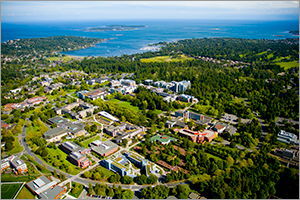State of Knowledge Workshop on Atmospheric Rivers
April 19, 2013
The Ministry of Environment Canada, the Pacific Climate Impacts Consortium and the Pacific Institute of Climate Solutions, both affiliated with the University of Victoria's Institute of Climate, sponsored a two day workshop in Victoria Canada on the current "state of the science" on land-falling Atmospheric Rivers in British Columbia.
The workshop's goals were to document the current understanding of extreme precipitation events, and identify gaps in knowledge. The event brought together climatologists, forecasters, emergency managers and policy advisors from the Pacific and Yukon Region of Canada to participate in discussions and make presentations. An estimated 75 people attended the workshop. Dr. Marty Ralph, Chief of the NOAA Earth System Reaserch Laboratory's Water Cycle Branch was a keynote speaker at the workshop and presented an invited public presentation at the University of Victoria as part of their IdeaFest 2013 lecture series. The lecture entitled Storms, Floods and Atmospheric Rivers—Putting the Extreme into West Coast Extremes was attended by over 100 students, faculty and the general public.

The workshop started out with an evening reception where Dr. Michel Jean, Director General Weather and Environmental Operations, Meteorological Service of Canada, Environment Canada who recognized the importance of understanding extreme rainfall events both now as well as future trends under climate change. His remarks highlighted the fact that Environment Canada headquarters recognizes the impacts of Atmospheric Rivers and that a priority is needed for future monitoring and forecasting, especially if these phenomena become stronger under a warmer climate. The morning of the workshop included presentations from the Director of Flood Protection, Emergency Management British Columbia highlighting the needs of her agency for adequate lead-time for preparing for extreme rainfall and flooding events, NOAA National Weather Service (NWS) Seattle's Ted Buehner, who reviewed NWS operations during the Howard Hansen Dam repair work where HMT played a major role in providing critical observations via an Atmospheric River Observatory upstream on the coast of Washington. These presentations were followed by a panel discussion where it was brought out that it is very important to be able to identify the main impacts of an upcoming event and not just the amount of rainfall possible. The lack of observations along the coast and upstream of British Columbia has made this difficult for those who brief the Emergency Management community on impending events. A very interesting discussion of the climatology of extreme rainfall events along the Canadian West Coast occurred and was followed by a talk on potential trends in extreme events using climate models.
Afternoon sessions included challenges and tools used for forecasting extreme events, where Dr Ralph provided a review of a decade of research on observing and forecasting ARs. Dave Reynolds, from PSD, and former MIC at NWS Monterey, was also an invited attendee, and provided comments on his experience in not only forecasting ARs but in briefing California's Office of Emergency Management, during expected state-wide extreme events. The other speaker was from the Pacific Storm Prediction Center, which is a small cadre of personnel who staff are responsible for developing training material and conducting training for Environment Canada forecasters, as well as providing the briefings to Emergency Management on extreme events. The afternoon of the workshop was a brainstorming session for participants to identify the priorities needed for improving forecasts and improving climate outlooks for the frequency and intensity of future extreme events. One of the main outcomes of this discussion was identification of gaps in key observations along the coastal areas of British Columbia (wind directions aloft, freezing levels, and moisture flux into the interior of British Columbia) as well as observations of the soil moisture within interior mountainous regions to understand potential runoff scenarios. The outcome of the workshop will be a "State of Knowledge" report and also a policy paper for policy makers written in laymen's terms to inform them of where best to appropriate funds for mitigating impacts of these extreme events. Given HMT's experience and knowledge base in both observing systems and forecasting tools, there is a great opportunity for HMT to participate in these efforts in British Columbia.